
by Rick O'Connor | May 17, 2019
I am writing about this animal because, though it is rare to see them, our terrapin volunteers saw two this past week; and maybe you will too.
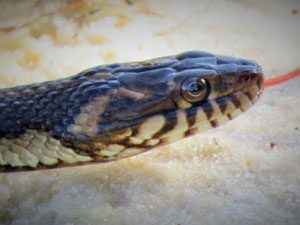
The round pupil and vertical jaw stripes indicate this is the nonvenomous Nerodia. Photo: Carole Tebay
The Gulf salt marsh snake is one of those, like the eastern coral snake, that is actually common – just rare to see. It is rare to see because (a) it lives in muddy salt marshes, where we rarely venture, and (b) it is mostly nocturnal – and even fewer of us venture into muddy salt marshes at night.
It is in the genus Nerodia, which includes the common water snakes like the banded water snake (Nerodia fasicata). It is a harmless nonvenomous snake. However, because of where it lives, it is often confused with a cottonmouth and is killed. A common name for this snake in Alabama is “bay moccasin”.
Their name is Nerodia clarkii, but it is a subspecies of this group – so the actual name is Nerodia clarkii clarkii. The other two subspecies are found in Florida. The Mangrove salt marsh snake (Nerodia clarkii compressicauda) is found from central Gulf coast of Florida, around the Keys to Indian River County on the Atlantic coast. The Atlantic salt marsh snake (Nerodia clarkii taeniata) has a very small range. Originally reported in Volusia, Brevard, and Indian River counties – due to the northern expansion of mangroves, it is believed to only be in Volusia County now. It is listed as THREATENED both federally and with the state. Our Gulf salt marsh snake is found from central Florida to Texas.
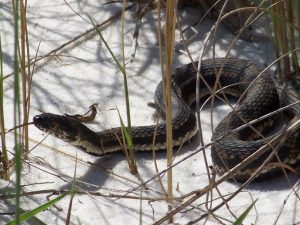
The nonvenomous Gulf Salt marsh Snake.
Photo: Molly O’Connor
It is a relatively small snake, only reaching a length of around 15-20 inches, though some have been reported at 30 inches. They possess two long yellowish-tan stripes running laterally the length of its body, the only species of Nerodia to do so. Again, they move at night feeding on small crabs, shrimp, frogs, and small fish. During daylight hours they hide beneath the wrack or other vegetation avoiding herons, egrets, and larger blue crabs. Lacking the needed glands, they cannot desalinate seawater the way sea turtles and terrapins can. All of their freshwater comes from their food and from rainfall.
They breed in the spring, possibly why we are seeing them now, and give live birth to about 10 young in midsummer. They are of moderate conservation concern in Alabama due to the loss of salt marsh. The loss of salt marsh habitat and rise of sea level are their major concerns at this point.
I do need to warn you, though it is a small, nonvenomous snake, they will bite. If bitten, soap and water will do the job. For me, and others, it is actually exciting to see them because of their reclusive nature. If you see one while exploring our intracoastal waters, know that you are not in any danger but rather lucky to see this “mystery of the marsh”.
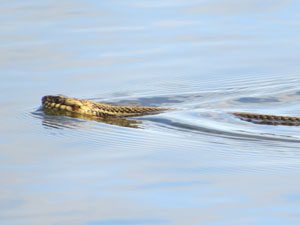
The Gulf Salt Marsh Snake swimming in a local marsh.
Photo: Carole Tebay
References
Gulf Salt Marsh Snake – Texas Parks and Recreation – https://tpwd.texas.gov/huntwild/wild/species/gulfsnake/.
iNaturalist – https://www.inaturalist.org/guide_taxa/776612.
Outdoor Alabama – Alabama Department of Conservation and Natural Resources – https://www.outdooralabama.com/non-venomous-snakes/gulf-saltmarsh-snake.
Atlantic Salt Marsh Snake – N.c.taeniata – U.S. Fish and Wildlife – https://www.fws.gov/northflorida/Species-Accounts/Atl-Salt-Marsh-Snake-2005.htm.
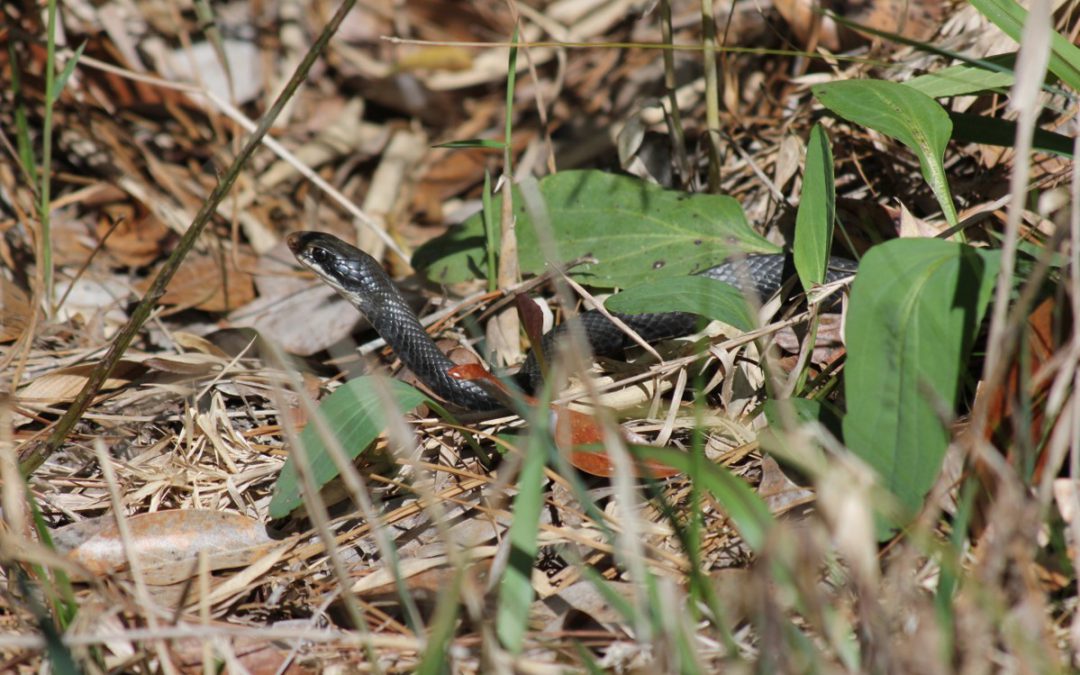
by Rick O'Connor | Jan 31, 2019
As we begin our wildlife series for 2019, we will start with a snake that almost everyone has encountered but knows little about – the southern black racer.
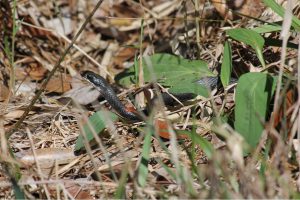
The southern black racer differs from other black snakes in its brilliant white chin and thin sleek body.
Photo: Jacqui Berger.
This snake is common for many reasons.
- It is found throughout the eastern United States
- It is diurnal, meaning active during daylight hours when we are out and about
- It can be found in a variety of habitats and is particularly fond of “edge” areas between forest and open habitat – they do very well around humans.
The southern black racer (Coluber constrictor priapus) is one of eight subspecies of this snake found in the United States. This local variety is a beautiful shiny black. The shine is due to the fact that they have smooth, rather than keeled, scales. It is a long snake, reaching up to six feet, but very thin – and very fast! Most of us see it just before it darts away.
They are sometimes confused with the cottonmouth. It can be distinguished in having a long “thin” body, as compared to the cottonmouths shorter “thick” body. It has a brilliant white chin and the top of the head is solid black. Cottonmouths can be mottled, usually have a cream-colored chin with a dark “mask” extending from the lower point of the chin through the eye. Cottonmouths also have the wide delta shaped head compared the finger-shaped head of the racer. They are also confused with the eastern indigo snake. The indigo is very long (up to eight feet) large bodied snake, and the lower chin is a reddish-orange color. The coachwhip is a close cousin of the racer, found in many of the same habitats. It has a similar body shape, and speed, but is a light tan color with a dark brown-black head and neck.
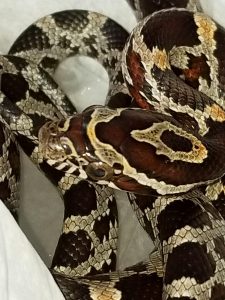
The juvenile black racer looks more like a corn snake, and is sometimes confused with a pygmy rattler.
Photo: C. Kelly
The juvenile looks nothing like the adult. The young racers hatch from rough covered eggs laid in late winter and early spring. They typically lay between 6-20 eggs and hide them under rocks, boards, bark, and even in openings in the side of homes. In late spring and early summer, they hatch. Their body resembles adults, but their coloration is a mottled mix of grays, browns, and reds – having distinct patches on their backs. This helps with camouflage but often they are mistaken for pygmy rattlesnakes and are killed.
They are great climbers and are found in our shrubs and trees, as well as on our houses and in our garages. Though sometimes confused with the cottonmouth, this snake is non-venomous and harmless. Harmless in the sense that a bite from will cause no harm – but it will bite. Black racers are notorious for this. If approached, it generally freezes first – to avoid detection. If it believes it has been detected, it will flee at amazing speeds. If it cannot flee, it will turn and bite… repeatedly. Again, the bites are harmless, but could draw blood. Cleaning with soap and water is all you need.
They are opportunistic feeders hunting a variety of prey including small mammals, reptiles, birds, insects, and eggs. They also hunt snakes, including small venomous species. Unlike the larger venomous snakes, black racers stalk their prey – many times with their heads raised similar to cobras. When prey is detected, they spring on them with lighting speed. Despite the scientific name “constrictor”, they do not constrict their prey, rather pin it down and wait for it to suffocate.
They do have their predators, particularly hawks. When approached they will first freeze to avoid detection, they may release a foul-smelling musk as a warning, and sometimes will vibrate their tails. In leaf-litter, this can sound very similar to a rattlesnake – not helping with the juvenile identification confusion. One paper reported finding a dead great horned owl with a black racer in its talons. Apparently, the owl grabbed the snake too far back. It killed the snake but not before the snake was able to strangle the owl.
They are hibernating this time of year but will soon be laying another clutch of eggs and we will once again encounter this most common of snakes.
References
Florida Museum of Natural History. Southern Black Racer (Coluber constrictor priapus). http://www.floridamuseum.ufl.edu/herpetology/fl-snakes/list/coluber-constrictor-priapus/.
Gibbons, W., M/ Dorcas. 2005. Snakes of the Southeast. University of Georgia Press, Athens GA. pp. 253.
Perry, R.W., R.E. Brown, D.C. Rudolph. 2001. Mutual Mortality of a Great Horned Owl and a Southern Black Racer: a Potential Risk for Raptors Preying on Snakes. The Willson Bulletin, 113(3). http://doi.org/10.1676/0043-5643(2001)113[0345:MMOGH0]2.0.CO;2.
Willson, J.D. Species Profile: Black Racer (Coluber constrictor priapus). SREL Herpetology. www.srelherp.uga.edu/snakes/colcon.htm.
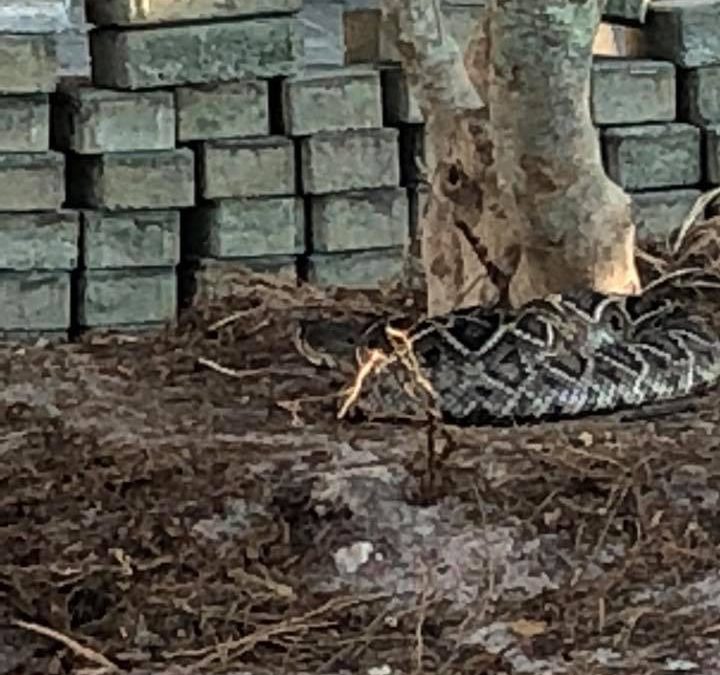
by Rick O'Connor | Dec 7, 2018
This seems like a strange title… of course they are still around. However, it is referring to the number of encounters beach residents in the Pensacola Beach have had this year. The first report was of a large individual coiled beneath a palm tree near a condominium unit by the gate of Ft. Pickens. Park officials relocated that snake. Soon after, another individual was found swimming in the surf of the Gulf of Mexico within the national seashore (honest… that is a strange place to find a rattlesnake). A third was photographed snake crawling near the gate at Johnson’s Beach on Perdido Key, again within the national seashore. I found a small individual coiled in the hollow space of a live oak tree at Naval Live Oaks in Gulf Breeze, again – within the seashore. And last week I was driving through the Ft. Pickens area and saw another crossing the road near Battery Worth; it safely made it across the road.
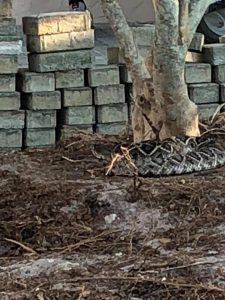
Diamondback rattlesnake near condominium construction site Pensacola Beach.
Photo: Sawyer Asmar
Some would say, “Safely made it across the road? I would not worry about safely making it across the road” – but most of you know I am a fan of snakes and do not wish them ill will. Others feel similar but would rather they stay away from people. I get that. Some would have tried to run over the snake so that it was not a threat to others in the park. I understand that thought process also but, as had been said before by many, snakes are beneficial to the ecosystem – benefitting us by controlling disease-carrying rodents, and rarely approaching people – it is usually the other way around. Besides, this is a national park – you cannot run over snakes there.
So what’s up with all the recent encounters?
Is the island overrun with snakes?
This question came up last spring over on Perdido Key when a community was frequently encountering cottonmouths. It would obviously take a population assessment by a qualified herpetologist to determine the density of snakes per acre; but no such study is being conducted – nor are there plans for one anytime soon. They tend to avoid people and, typically, become more visible when they are pushed from their hiding places. They are also more visible during breeding season, which for the eastern diamondback rattlesnake is late summer and fall.
There is concern for safety when discussing the rattlesnake. So let’s learn a little more about this animal. To know them better is to learn how to avoid problems with them.
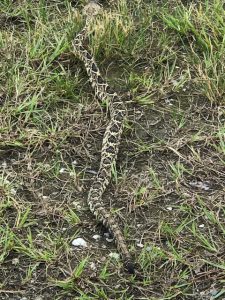
Eastern diamondback rattlesnake crawling near Ft. Pickens Campground.
Photo: Shelley Johnson
The Eastern Diamondback Rattlesnake (Crotalus adamanteus) is the largest venomous snake in North America, reaching lengths of eight feet and 4-6 lbs. (though some have weighed as much as 15 lbs.). They prefer high dry ground, such as the dune fields of barrier islands, feed on a variety of rodents, and have a particular fondness for rabbits. Word is, if there are rabbits – there may be rattlesnakes.
When small, they have numerous predators including raptors, mammals, and even bullfrogs. To defend themselves, they lie beneath vegetation cover during the summer months and within burrows and stump holes in the winter. Unlike the cottonmouth, rattlesnakes prefer to hunt during the daylight hours.
They breed in the fall just before the first cold temperatures and then settle into a burrow for the winter. They will have 12-24 young, delivered live, and the females will stay with the young until they shed their first skin, at which time the young are on their own.
They tend to avoid human contact and rarely venture into our territory unless (a) we have provided good habitat for their prey, (b) we have reduced their preferred habitat to a point they have no choice. Locally, all recent encounters (less one) have been within the National Seashore. One encounter was in the dune fields near Big Sabine. These are all natural habitats far from people – which is a good thing.
Rattlesnake venom is potent, and people should keep a respectful distance for this animal. My college professor said their venom is “expensive” and meant for killing prey. What he meant by “expensive” was in terms of the energy and compounds to produce it. That said, they would inject venom if their life depended on it. One encounter I read about on a barrier island in Georgia involved a large eastern diamondback. He said the head was close to 4 inches and the coiled body was large enough to cover a manhole. He was not sure how long the snake was, but needless to say – it was a large snake. He was actually a herpetologist who works with snakes and was searching for them. He had a steel snake tong with him. He used that to cover his leg and walked past the snake. The snake never made an attempt to strike convinced it was camouflaged and did not need to. He looked back after walking a few feet and the rattlesnake remained in the coiled position awaiting a rabbit. Snakes that are annoyed will often rattle and lift into the S-shape strike position. You should give an animal doing this plenty of room, their strike range is 2/3 their body length.
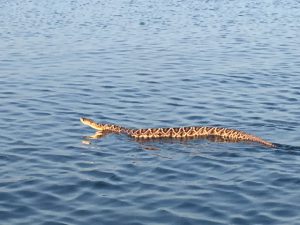
Eastern diamondback rattlesnake swimming in intracoastal waterway near Ft. McRee in Pensacola.
Photo: Sue Saffron
Despite our fears, these are fascinating and beneficial animals. There is a variety of reasons we may be seeing more on our barrier islands, but understanding them will help reduce negative encounters.
References
Gibbons, W. M. Dorcas. 2005. Snakes of the Southeast. University of Georgia Press. Athens GA. pp. 253.
Graham, S. 2018. American Snakes. John Hopkins University Press. Baltimore MD. pp. 293.
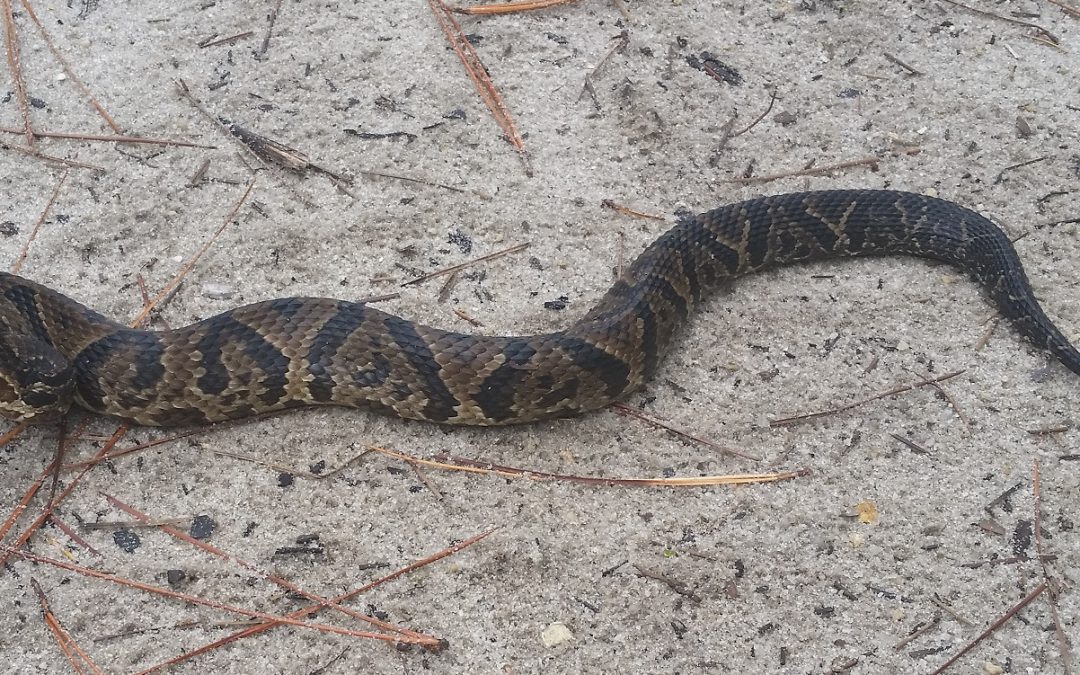
by Erik Lovestrand | Nov 26, 2018
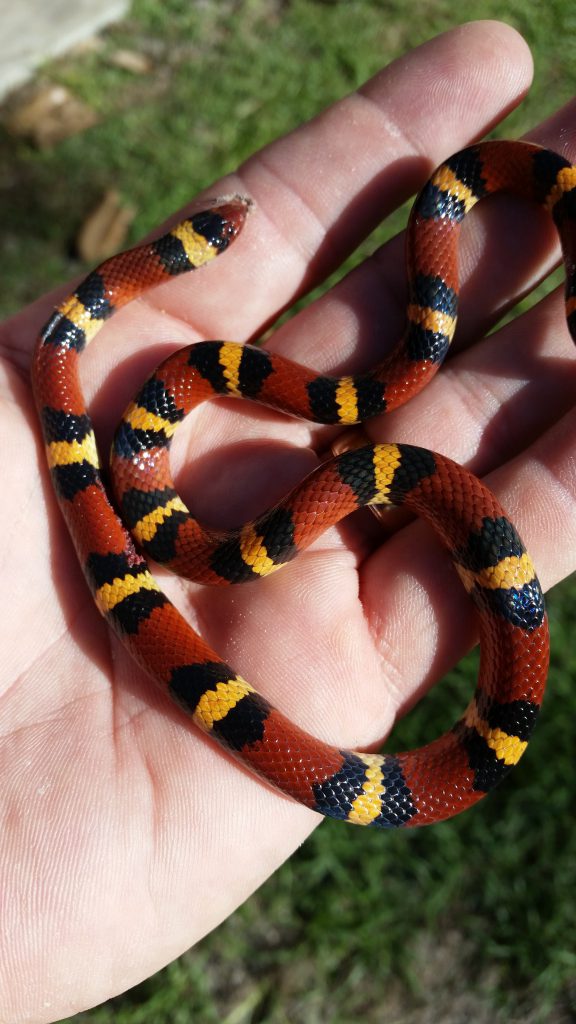
This beautiful scarlet kingsnake was run over near the author’s home
Snakes are some of the coolest animals on the planet but I’ll admit to something right up front; when a snake surprises me, I still jump, often. Even if I seem composed on the outside, something inside me almost always jumps. It does not matter if it is a venomous species or not. In spite of my basic understanding of and great appreciation for reptiles, snakes connect with a primal instinct that shouts “lookout” at some subconscious level. This human character trait is most-often the undoing of many an innocent serpent, happily going about its business when, WHAM, lights out. When a snake dares touch the human subconscious, our first emotion is often shock or fear; then perhaps anger; and in the end, payback for the offense. Many a good snake has met a very bad end when it has surprised a person.
Shock and fear are powerful emotions and I can almost (not totally) understand the outcome described above when someone is honestly shocked by a snake’s unexpected appearance. Nevertheless, even my wife, during a shocking encounter with a 5-foot oak snake while collecting eggs in the chicken house, was able gather her wits and shoo the critter out of the coop with a stick, rather than kill it. She did have me go the next evening to get the eggs though.
The one thing I have no empathy for however is when folks go out of their way to kill a snake that is trying to cross one of our roadways. About 90% of the dead snakes I see on the road are so close to the edge of the pavement that they were easily avoidable. C’mon people, that should be a “snake-safe” zone. These animals are likely never to encounter a human as they go about their business, performing important ecological functions in their natural habitat. Their great misfortune was that they had to cross an asphalt corridor used by humans. How about providing the same courtesy that most folks do when they see a turtle on the highway.
I see my share of cottonmouths smashed on the road (and that’s a shame too in my book) but other flattened species I’ve encountered include mud snakes, rat snakes, garter snakes, ribbon snakes, water snakes, racers, scarlet kingsnakes, green snakes, and many more; all harmless creatures. Recently, I stopped to look at a nice 4-foot coachwhip; a beautiful specimen, except for the fact that it was dead.
I get a thrill in seeing a living snake and having the chance to marvel at its form, function and beauty. If you ever have the chance to look closely at a pygmy rattlesnake in the wild (hopefully not in your turkey blind) you will be blown-away by its magnificent beauty. Black, velvety blotches on a gray background, with a rusty stripe running down the middle of its back. Same thing for a large diamondback rattlesnake (from a respectable distance). These have been some of my favorite natural encounters in the woods of North Florida, where we are truly blessed with a diversity of amazing animals and yes, super-amazing snakes. We should always use common sense of course when roaming the woods and enjoying our wild encounters, i.e. don’t ever catch venomous snakes (not worth the thrill), keep your hands out of hidden places, and watch where you put your feet. Oh, and work on cultivating a “live and let live” attitude when it comes to our scaly friends on the highway. They will oblige likewise.
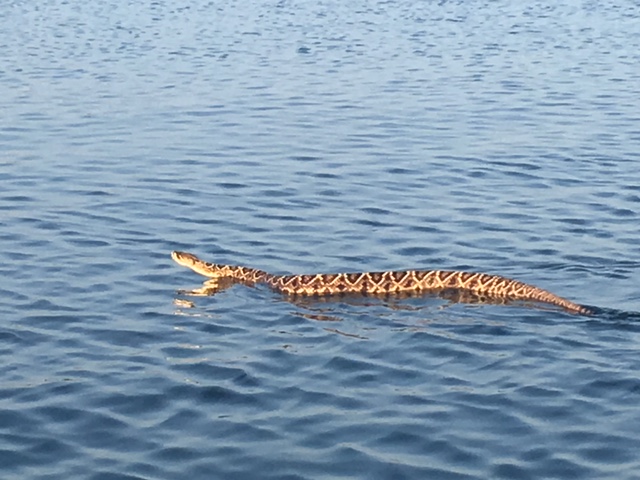
by Rick O'Connor | Sep 28, 2018
In the past week, three eastern diamondback rattlesnakes were encountered near the Ft. Pickens area on Pensacola Beach. The first was at a condominium unit near the park gate where construction work was occurring, the second was found swimming in the surf of the Gulf of Mexico within the national seashore, and the third was in the national seashore’s campground. This is an animal we rarely encounter on our barrier islands – but that is the keyword… encounter… they are there, but tend to avoid us.

Eastern diamondback rattlesnake crawling near Ft. Pickens Campground.
Photo: Shelley Johnson
Report on rattlesnake in Gulf surf –
https://www.pnj.com/story/news/local/2018/09/26/snake-rescue-pensacola-beach-shocks-visitors/1430731002/
The eastern diamondback rattlesnakes (Crotalus adamanteus) is the largest venomous snake in the United States. An average snake will reach six feet and five pounds, but they can reach eight feet and up to 15 pounds. Because of their large bodies, they tend to move slow and do not often try to escape when approached by humans. Rather, they lie still and quite hoping to be missed. If they do feel you have come to close, they will give their signature rattle as a warning – though this does not always happen. If they are considering the idea of striking – they will raise their head in the classic “S” formation. Know that their strike range is 2/3 their body length – larger than many other native snakes – so a four foot snake could have a three foot strike range. Give these snakes plenty of clearance.
Eastern diamondback rattlesnakes prefer dry sandy habitats, though they are also found in pine flatwoods (such as Naval Live Oaks north of highway 98 in Gulf Breeze). They are quite common in the upland sandhills of longleaf pine forests. They spend the day in tree stump holes and gopher burrows and hunt small mammals and birds in the evenings. They are particular fond of rabbits. The dunes of our barrier islands are very similar to the sandhills of the pine forest further north. They are actually good swimmers and saltwater is not a barrier – distance is. They have been seen numerous times swimming from Gulf to Pensacola Beach or the opposite. Again, they tend to avoid encounters with humans and are not often found on lawns etc.
Diamondbacks give birth to live young around August. The females will find a dark-cool location to den and give birth several young. Anywhere from four to 32 offspring have been reported. The female remains with the young for about 10 days until they have their first molt (skin shedding) and then she leaves them to their fate.

Diamondback rattlesnake near condominium construction site Pensacola Beach.
Photo: Sawyer Asmar
So what’s up with three encounters in a relatively small location within one week?
My first inclination is two possibilities – maybe a combination of the two.
- We have had a lot of rain this year – and then T.S. Gordon came through. Snakes like to be on high dry ground as much as anyone else and they tend to move closer to human habitats because they are built on higher ground.
- Breeding season for eastern diamondbacks is late summer early fall. This time of year, the males are on the move seeking interested females – so they are encountered more.
As far as finding one in the surf of the Gulf of Mexico. I am not sure. I have never seen this and the newspaper account suggested it was not doing well when found. Again, I have seen plenty swimming the Intracoastal but this is a first for the Gulf. I would say it had wondered the wrong way.
They are actually fascinating animals and are not a threat unless you approach too close. Give them room and feel lucky if you get to see one.
References
Eastern Diamondback Rattlesnake. Natural History. Center for Biological Diversity. https://www.biologicaldiversity.org/species/reptiles/eastern_diamondback_rattlesnake/natural_history.html.
Krysko, Kenneth L., and F. Wayne King. 2014. Online Guide to the Snakes of Florida. Florida Museum of Natural History, University of Florida, Gainesville, FL, USA. [Online: September 2014] Available at: http://www.flmnh.ufl.edu/herpetology.
https://www.floridamuseum.ufl.edu/herpetology/fl-snakes/list/crotalus-adamanteus.
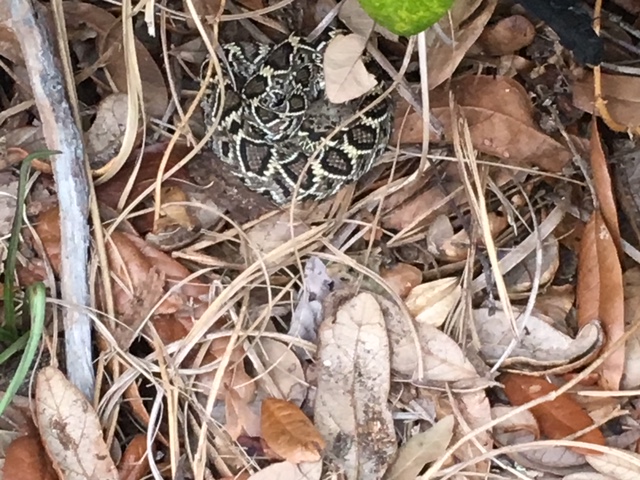
by Rick O'Connor | Mar 9, 2018
Most people know that snakes are ectothermic and the environment is what regulates their body temperature. However, many do not know that they like to maintain their temperature close to 98 F like us. To do this they must move to locations where they can either warm (like basking in the sun or lying on warm asphalt) or cool (like under rocks or logs). Unlike us, their temperature can rise to above 100 F or down close to 30 F with few health problems.
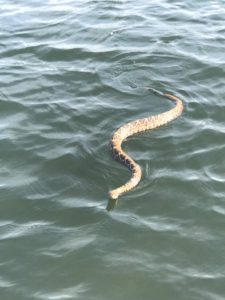
Eastern Diamondback Rattlesnake swimming across the Intracoastal Waterway near Pensacola Beach.
Photo: Andy Barnes
When environmental temperatures become colder, their heart and breathing rates slow significantly. Their blood oxygen levels decrease, and they become very slow and sluggish – a condition we call torpor. There are some advantages to this, such as not having to hunt for food for several weeks or months, but when the air temperatures begin to climb they become more active… Moreover, their hungry.
In the last two weeks, I have had numerous reports of snakes moving around in yards. There have been three records of diamondback rattlesnakes in the Pensacola Beach area alone.
Should I be concerned about doing outdoor activities?
No, not really – but you should be aware. As it warms, snakes will become more active early in the morning and late in the evening. Pit vipers, like rattlesnakes and cottonmouths, actually prefer hunting at night. However, when the temperatures are cool enough for mid-day movement, they will. Food and reproduction (for some species) are on their mind this time of year.
Stay on the trails – snakes typically do not like to be in the open because of predators but they do have to bask to increase their body metabolism; so they may be along the edge. If I am hiking, I tend to look down along the trail when walking. If I want to observe something in the trees, I stop.
These snake movements happen every year, and very people have problems, but with the recent increase in encounters it is could to be aware. I actually think snakes are pretty cool. I enjoy seeing them, especially ones that are not viewed very often like coral snakes and rattlesnakes. You should still go out and enjoy the Pensacola Bay area. It is a great time of year to do it.
















